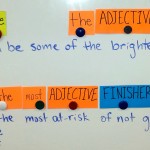I know I have written about this topic before, the relationship between standards and standardization, instructional innovation and teaching for creativity, and standardized tests, but I am going to take another go at it, because this year I changed levels and content. I went from teaching high school English to teaching English Language Development to 7th and 8th graders.
The world of ELD is very different from that of English Language Arts. Fact: In Arizona, the only two groups of students whose educational paths are determined by a single standardized test are our English Language Learners (through the AZELLA test) and our 3rd Graders (through the initiative Move on When Reading.) For an English language learner, AZELLA determines whether they will have four hours of English language instruction per day, two hours, or become mainstreamed into regular English language arts classes with most of the other students. At the high school level, the time spent in ELD can (and does) affect credits for graduation, and has an impact on graduation rates for ELL’s.
Students who have been in ELD for several years often regard the test with a level of numbness, anxiety or resentment, mixed with a flutter of hope. Parents can remove students from ELD at any time, but this decision is fraught with worry that they are taking their son or daughter out of classes that they really need. Removing students from the program is a tough choice considering that Arizona’s ELL’s have seen a drop in their test scores, graduation rates and other indicators since 2003. They need help. AZELLA is what is used in Arizona to determine whether they need that help.
AZELLA causes a lot of stress for ELD teachers. All the ELD teachers I know do their best to get their students through that test and on with their lives. They have their students in mind, but also their own professional reputation and sense of competency. Administrators look at passing rates. School improvement plans often include a goal for the percentage of students passing AZELLA in any given year, as ours did this year. The state audits district programs. So, to varying degrees, ELD teachers feel pressure to teach to the AZELLA test. Every ELD teacher I know does at least some specifically targeted test preparation.
This year, I was a newbie at teaching English Language Development. The number of ELD standards is overwhelming. The document for my level, Stage IV, is 130 pages long. I cherished the opportunity to build curriculum, but most of this year was spent sorting through the standards, picking the ones I felt were richest with potential, and designing lessons around those. I received some excellent professional support in our district and relied on the internet heavily. First semester I did not have a moment to think about the format of the AZELLA test, though I knew the basic gist of it.
Even headed into January, I knew I needed to help my students prepare for AZELLA in February, but I was knee deep in research projects and independent reading, levels of questioning lessons and verb tense studies. Not to mention finding opportunities for my students to be part of the larger school community, such as packing food boxes for our holiday food drive, and keeping them from gossiping about one another in Spanish when they were supposed to be working. I was doing what I felt was best for students based on what I was learning about them on a daily basis. I grounded each lesson in the standards and looked for ways to bring in different opportunities for reading, writing, listening and speaking as we met each objective. I learned and taught as fast and as well as I could. I didn’t have any training in test prep except my old Kaplan SAT tutoring, and so I didn’t implement much. As AZELLA approached, we took some practice tests and gave students some generalized feedback, but to be honest I ran out of time to go through the practice exams in detail.
Here is what happened that makes my heart glad: 42% of my students tested proficient this spring. We also graduated two others out of the program in December. 47% of my 8th graders passed, which means they can have a normal high school schedule next year. Keep in mind that I had three monolingual Spanish speaking students come this spring from Mexico and several other students who would not be expected to pass, and all but one of my students improved by one or more of the five levels. Five of my students in the Introduction level class moved all the way to proficiency. And yes, I am bragging. I am proud of the work my students did this year, and relieved that my efforts took them in the right direction.
And here is the joyful lesson I have learned: Good teachers know what the kids need. Test prep is not the sole (or even possibly the major) determiner of success. Teachers (including myself) should continue to build the rigorous, authentic, multifaceted and responsive lessons we want to build. We should continue to innovate using the most up to date methods, ideas and tools we have. Even in the face of a high stakes test, good teaching is good teaching, and authentic learning is best.









Comments 1
So true, I am the Language Acquisition Mentor for our school, and facilitating the requirements of the ILLPs for each ELD student AND their teacher is so frustrating for everyone involved. I feel like we are jumping through crazy amounts of hoops to make our state “look good” when it comes to paperwork. I keep reminding the teachers, when they freak out by the 64 performance objectives required for each student for EACH quarter… it’s all about good teaching. Just teach what you know is best for that student, and it really comes together at the end.